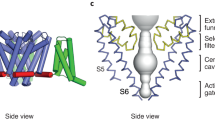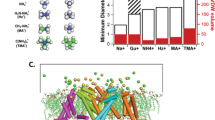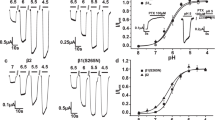Abstract
Gramicidin A is a pentadecapeptide of alternating L and D amino acids1. In membranes it forms cation conductive channels2 of molecular dimensions3,4 that in many respects resemble2–7 the channels of excitable cells8,9. For this reason, and also because its structure is well established1,10,11, the gramicidin channel is regarded as a useful model of ion channels in cell membranes. Although the properties of the gramicidin channel have been studied extensively12, it has generally been described as having a single state associated with a sharply defined conductance that remains unaltered during the lifetime of the channel13. We report here that, in fact, gramicidin A can assume other, less conductive ‘miniature’ (mini) states evidenced by our observations of spontaneous transitions in the conductance of single open channels and the observation of a significant number of weakly conducting channels. Current–voltage (I–V) relationships for different channel states differ significantly and, for minis, are often asymmetrical. Our results indicate that the gramicidin channel has a wide variety of stable conf ormational states that give rise to channels with different electrical properties. Because transitions between states occur relatively infrequently, these conf ormational states must be separated by relatively large energies of interconversion. Similar transitions, poised by the electric field or an agonist molecule, may underlie the function of gated channels in cell membranes.
This is a preview of subscription content, access via your institution
Access options
Subscribe to this journal
Receive 51 print issues and online access
$199.00 per year
only $3.90 per issue
Buy this article
- Purchase on Springer Link
- Instant access to full article PDF
Prices may be subject to local taxes which are calculated during checkout
Similar content being viewed by others
References
Sarges, R. & Witkop, B. J. Am. chem. Soc. 86, 1862–1863 (1964).
Myers, V. B. & Haydon, D. A. Biochim. biophys. Acta 274, 313–322 (1972).
Urry, D. W. Proc. natn. Acad. Sci. U.S.A. 68, 672–676 (1971).
Urry, D. W., Goodall, M. C., Glickson, J. D. & Mayers, F. D. Proc. natn. Acad. Sci. U.S.A. 68, 1907–1911 (1971).
Neher, E., Sandblom, J. & Eisenman, G. J. Membrane Biol. 40, 97–116 (1978).
Hladky, S. B. & Haydon, D. A. Biochim. biophys. Acta 274, 294–312 (1972).
Shagina, L., Grinfeldt, A. E. & Lev, A. A. Nature 273, 243–245 (1978).
Begenisich, T. B. & Cahalan, M. D. J. Physiol., Lond. 307, 217–242 (1980).
Hodgkin, A. L. & Keynes, R. D. J. Physiol., Lond. 128, 61–88 (1955).
Urry, D. W. in Conformation of Biological Molecules and Polymers—The Jerusalem Symp. on Quantum Chemistry and Biochemistry Vol. 5, 723–736 (Jerusalem Academy of Sciences, 1973).
Koeppe, R. E., Hodgson, K. O. & Stryer, L. J. molec. Biol. 121, 41–54 (1978).
Bamberg, E. et al. Fedn Proc. 37, 2633–2638 (1978).
Haydon, D. A. & Hladky, S. B. Q. Rev. Biophys. 5, 187–282 (1972).
Gross, E. & Witkop, B. Biochemistry 4, 2495–2501 (1965).
White, S. Biophys. J. 23, 337–347 (1978).
Apell, H.-J., Bamberg, E., Alpes, H. & Läuger, P. J. Membrane Biol. 31, 171–181 (1977).
Frohlich, O. J. Membrane Biol. 48, 365–383 (1979).
Hladky, S. B. & Haydon, D. A. Nature 225, 451–453 (1970).
Bamberg, E. & Läuger, P. Biochim. biophys. Acta 367, 127–133 (1974).
Prasad, K. U., Trapane, T. L., Busath, D., Szabo, G. & Urry, D. W. Int. J. Peptide Protein Res. 18 (in the press).
Bamberg, E., Noda, K., Gross, E. & Läuger, P. Biochim. biophys. Acta 419, 223–228 (1976).
Bamberg, E. & Läuger, P. J. Membrane Biol. 11, 177–194 (1973).
Veatch, W. R., Mathies, R., Eisenberg, M. & Stryer, L. J. molec. Biol. 99, 75–92 (1975).
Bamberg, E., Appel, H.-J. & Alpes, H. Proc. natn. Acad. Sci. U.S.A. 74, 2402–2406 (1977).
Bamberg, E. et al. J. Membrane Biol. 50, 257–270 (1979).
Veatch, W. R., Fossel, E. T. & Blout, E. R. Biochemistry 13, 5249–5256 (1974).
Ochinnikov, Y. A. Eur. J. Biochem. 94, 321–336 (1979).
Urry, D. W., Venkatachalam, C. M. & Prasad, K. U. J. Quantum Chem., Quantum Biol. Symp. 8 (in the press).
Author information
Authors and Affiliations
Rights and permissions
About this article
Cite this article
Busath, D., Szabo, G. Gramicidin forms multi-state rectifying channels. Nature 294, 371–373 (1981). https://doi.org/10.1038/294371a0
Received:
Accepted:
Issue Date:
DOI: https://doi.org/10.1038/294371a0
This article is cited by
-
Electronic control of H+ current in a bioprotonic device with Gramicidin A and Alamethicin
Nature Communications (2016)
-
H+-type and OH−-type biological protonic semiconductors and complementary devices
Scientific Reports (2013)
-
A polysaccharide bioprotonic field-effect transistor
Nature Communications (2011)
-
Ion channel subconductance states
The Journal of Membrane Biology (1987)
-
Temperature-jump and voltage-jump experiments at planar lipid membranes support an aggregational (micellar) model of the gramicidin A ion channel
The Journal of Membrane Biology (1986)
Comments
By submitting a comment you agree to abide by our Terms and Community Guidelines. If you find something abusive or that does not comply with our terms or guidelines please flag it as inappropriate.



